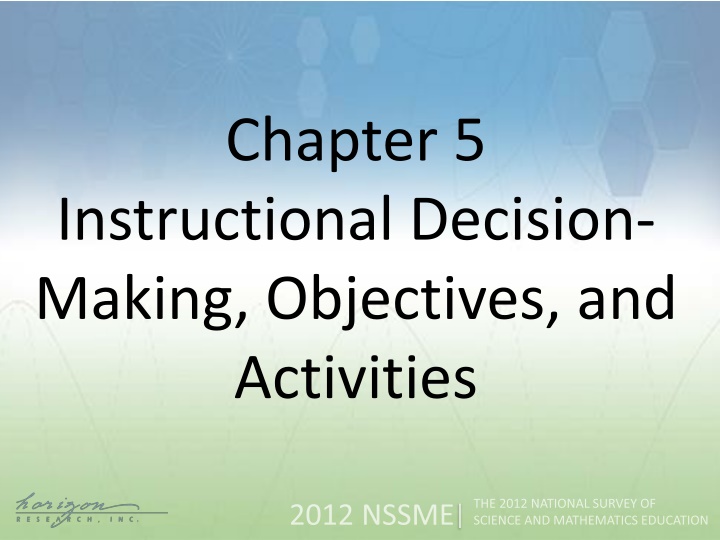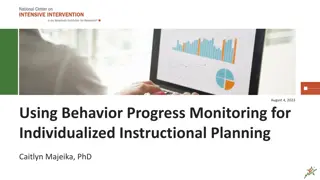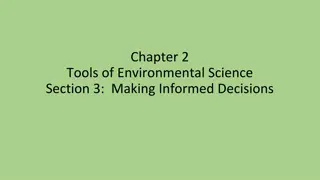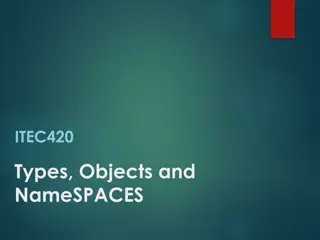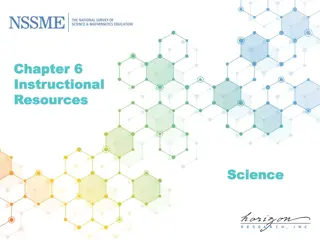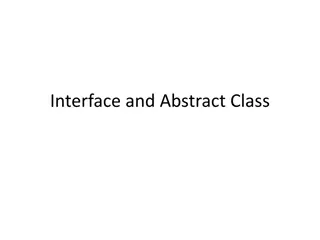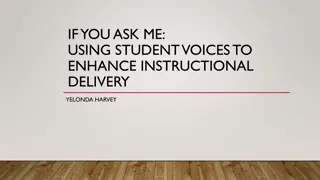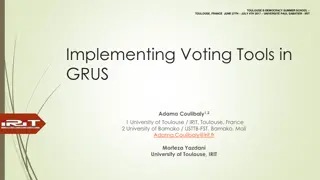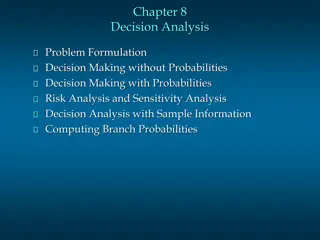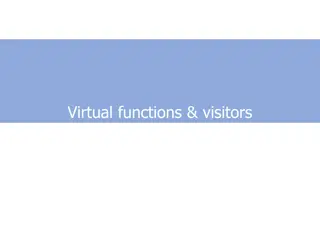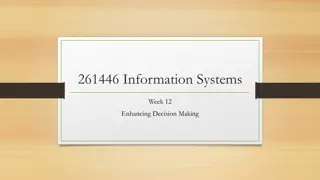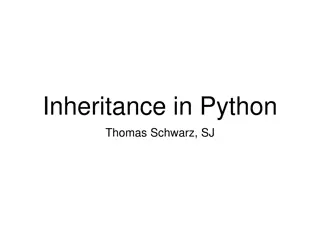Instructional Decision-Making in Science Classes
This content delves into teachers' perceptions of decision-making autonomy in science classes at different school levels. It presents data on the level of control teachers report in various curriculum and instruction decisions, such as homework assignment, teaching techniques, grading criteria, course goals, content selection, and textbook choices. The visuals illustrate the percentage of classes where teachers have strong control over these decisions in elementary, middle, and high school science classes.
Uploaded on May 01, 2025 | 1 Views
Download Presentation

Please find below an Image/Link to download the presentation.
The content on the website is provided AS IS for your information and personal use only. It may not be sold, licensed, or shared on other websites without obtaining consent from the author.If you encounter any issues during the download, it is possible that the publisher has removed the file from their server.
You are allowed to download the files provided on this website for personal or commercial use, subject to the condition that they are used lawfully. All files are the property of their respective owners.
The content on the website is provided AS IS for your information and personal use only. It may not be sold, licensed, or shared on other websites without obtaining consent from the author.
E N D
Presentation Transcript
Chapter 5 Instructional Decision- Making, Objectives, and Activities
Teachers Perceptions of Their Decision- Making Autonomy
Original Data for Slides 57 (not for presentation) Table 5.1 Science Classes in Which Teachers Report Having Strong Control Over Various Curriculum and Instruction Decisions, by Grade Range Determining the amount of homework to be assigned Selecting teaching techniques Choosing criteria for grading student performance Determining course goals and objectives Selecting content, topics, and skills to be taught Selecting textbooks/modules Percent of Classes Middle 75 67 58 21 20 14 Elementary 64 (2.7) 53 (2.5) 43 (3.3) 14 (2.0) 10 (1.8) 5 (1.1) High 76 73 61 36 35 33 (3.2) (3.6) (3.5) (3.0) (2.9) (2.7) (1.9) (2.0) (2.3) (2.3) (2.7) (2.6)
Elementary School Science Classes in Which Teachers Report Having Strong Control Over Various Decisions Determining the amount of homework to be assigned 64 Selecting teaching techniques 53 Choosing criteria for grading student performance 43 Determining course goals and objectives 14 Selecting content, topics, and skills to be taught 10 Selecting textbooks/modules 5 0 20 40 60 80 100 Percent of Classes
Middle School Science Classes in Which Teachers Report Having Strong Control Over Various Decisions Determining the amount of homework to be assigned 75 Selecting teaching techniques 67 Choosing criteria for grading student performance 58 Determining course goals and objectives 21 Selecting content, topics, and skills to be taught 20 Selecting textbooks/modules 14 0 20 40 60 80 100 Percent of Classes
High School Science Classes in Which Teachers Report Having Strong Control Over Various Decisions Determining the amount of homework to be assigned 76 Selecting teaching techniques 73 Choosing criteria for grading student performance 61 Determining course goals and objectives 36 Selecting content, topics, and skills to be taught 35 Selecting textbooks/modules 33 0 20 40 60 80 100 Percent of Classes
Original Data for Slide 9 (not for presentation) Table 5.3 Class Mean Scores for Curriculum Control and Pedagogical Control Composites, by Subject and Grade Range Mean Score Science Classes Elementary Middle High Curriculum 32 45 59 Pedagogical (1.7) (2.2) (1.6) (1.2) (1.3) (0.7) 81 88 89
Science Class Mean Scores for Curriculum and Pedagogical Control Composites, by Grade Range 100 89 88 81 80 Class Mean Score 59 60 45 40 32 20 0 Elementary Middle High Curriculum Pedagogical
Objectives of Science Instruction
Original Data for Slides 1214 (not for presentation) Table 5.5 Science Classes with Heavy Emphasis on Various Instructional Objectives, by Grade Range Percent of Classes Middle 80 (2.1) 57 (2.2) 54 (2.3) 40 (2.1) 45 (2.3) 24 (1.7) 10 (1.2) Understanding science concepts Increasing students interest in science Learning science process skills (e.g., observing, measuring) Preparing for further study in science Learning about real-life applications of science Learning test taking skills/strategies Memorizing science vocabulary and/or facts Elementary 59 (2.2) 56 (2.0) 47 (2.1) 35 (2.0) 46 (2.3) 22 (1.6) 10 (1.3) High 80 50 49 46 45 22 13 (1.2) (1.4) (1.6) (1.3) (1.5) (1.2) (1.3)
Elementary School Science Classes with Heavy Emphasis on Various Instructional Objectives Understanding science concepts 59 Increasing students interest in science 56 Learning science process skills 47 Learning about real-life applications of science 46 Preparing for further study in science 35 Learning test taking skills/strategies 22 Memorizing science vocabulary and/or facts 10 0 20 40 60 80 100 Percent of Classes
Middle School Science Classes with Heavy Emphasis on Various Instructional Objectives Understanding science concepts 80 Increasing students interest in science 57 Learning science process skills 54 Learning about real-life applications of science 45 Preparing for further study in science 40 Learning test taking skills/strategies 24 Memorizing science vocabulary and/or facts 10 0 20 40 60 80 100 Percent of Classes
High School Science Classes with Heavy Emphasis on Various Instructional Objectives Understanding science concepts 80 Increasing students interest in science 50 Learning science process skills 49 Preparing for further study in science 46 Learning about real-life applications of science 45 Learning test taking skills/strategies 22 Memorizing science vocabulary and/or facts 13 0 20 40 60 80 100 Percent of Classes
Original Data for Slides 1725 (not for presentation) Table 5.12 Science Classes in Which Teachers Report Using Various Activities at Least Once a Week, by Grade Range Explain science ideas to the whole class Engage the whole class in discussions Have students work in small groups Require students to supply evidence in support of their claims Give tests and/or quizzes that are predominantly short-answer (e.g., multiple choice, true /false, fill in the blank) Do hands-on/laboratory activities Have students represent and/or analyze data using tables, charts, or graphs Give tests and/or quizzes that include constructed-response/open- ended items Have students write their reflections (e.g., in their journals) in class or for homework Have students read from a science textbook, module, or other science-related material in class, either aloud or to themselves Have students practice for standardized tests Focus on literacy skills (e.g., informational reading or writing strategies) Engage the class in project-based learning (PBL) activities Have students make formal presentations to the rest of the class (e.g., on individual or group projects) Have students attend presentations by guest speakers focused on science and/or engineering in the workplace Percent of Classes Middle 96 92 79 64 Elementary 88 90 72 54 High 95 83 83 61 (1.3) (0.9) (1.8) (2.1) (0.9) (1.0) (1.9) (2.3) (0.8) (1.0) (1.2) (1.6) 31 55 (2.0) (1.9) 44 62 (2.4) (2.4) 44 70 (1.6) (1.5) 44 (2.0) 54 (1.9) 58 (1.6) 21 (1.7) 36 (2.1) 40 (1.4) 44 (2.0) 44 (2.1) 21 (1.3) 48 19 (2.4) (1.7) 56 23 (2.3) (1.9) 37 20 (1.6) (1.2) 48 (2.0) (1.7) 44 (2.2) (1.9) 25 (1.5) (1.2) 30 23 18 12 (1.2) 10 (1.4) 9 (1.0) 3 (0.6) 3 (0.8) 2 (0.5)
Elementary School Science Classes Using Various Activities at Least Once a Week Engage the whole class in discussions 90 Explain science ideas to the whole class 88 Have students work in small groups 72 Do hands-on/laboratory activities 55 Require students to supply evidence for claims 54 0 20 40 60 80 100 Percent of Classes
Elementary School Science Classes Using Various Activities at Least Once a Week Focus on literacy skills 48 Have students read from a textbook 48 Have students write their reflections 44 Have students represent data in tables/graphs 44 Give tests and/or quizzes that are predominantly short-answer 31 0 20 40 60 80 100 Percent of Classes
Elementary School Science Classes Using Various Activities at Least Once a Week Engage the class in project-based learning activities 30 Give tests/quizzes that include constructed/open-ended items 21 Have students practice for standardized tests 19 Have students make formal presentations to the rest of the class 12 Have students attend presentations by guest speakers 3 0 20 40 60 80 100 Percent of Classes
Middle School Science Classes Using Various Activities at Least Once a Week Explain science ideas to the whole class 96 Engage the whole class in discussions 92 Have students work in small groups 79 Require students to supply evidence for claims 64 Do hands-on/laboratory activities 62 0 20 40 60 80 100 Percent of Classes
Middle School Science Classes Using Various Activities at Least Once a Week Have students read from a textbook 56 Have students represent data in tables/graphs 54 Focus on literacy skills 44 Have students write their reflections 44 Give tests and/or quizzes that are predominantly short-answer 44 0 20 40 60 80 100 Percent of Classes
Middle School Science Classes Using Various Activities at Least Once a Week Give tests/quizzes that include constructed/open-ended items 36 Engage the class in project-based learning activities 23 Have students practice for standardized tests 23 Have students make formal presentations to the rest of the class 10 Have students attend presentations by guest speakers 3 0 20 40 60 80 100 Percent of Classes
High School Science Classes Using Various Activities at Least Once a Week Explain science ideas to the whole class 95 Have students work in small groups 83 Engage the whole class in discussions 83 Do hands-on/laboratory activities 70 Require students to supply evidence for claims 61 0 20 40 60 80 100 Percent of Classes
High School Science Classes Using Various Activities at Least Once a Week Have students represent data in tables/graphs 58 Give tests and/or quizzes that are predominantly short-answer 44 Give tests/quizzes that include constructed/open-ended items 40 Have students read from a textbook 37 Focus on literacy skills 25 0 20 40 60 80 100 Percent of Classes
High School Science Classes Using Various Activities at Least Once a Week Have students write their reflections 21 Have students practice for standardized tests 20 Engage the class in project-based learning activities 18 Have students make formal presentations to the rest of the class 9 Have students attend presentations by guest speakers 2 0 20 40 60 80 100 Percent of Classes
Original Data for Slides 2729 (not for presentation) Table 5.14 Science Classes in Which Teachers Report that Students Use Various Instructional Technologies at Least Once a Week, by Grade Range Percent of Classes Middle 32 23 2 4 2 6 Internet Personal computers, including laptops Calculators/Graphing calculators Hand-held computers Probes for collecting data Classroom response system or Clickers Elementary teachers were asked about their use of calculators, middle and high school teachers were asked about their use of graphing calculators. Elementary 31 (2.9) 21 (3.0) 8 (1.7) 2 (0.8) 7 (2.1) 8 (2.8) High 35 31 19 9 8 6 (2.7) (2.2) (0.5) (1.2) (0.6) (1.0) (2.2) (2.3) (1.7) (1.3) (1.1) (1.0)
Elementary School Science Classes in Which Students Use Various Technologies at Least Once a Week Internet 31 Personal computers, including laptops 21 Classroom response system or Clickers 8 Calculators 8 Probes for collecting data 7 Hand-held computers 2 0 20 40 60 80 100 Percent of Classes
Middle School Science Classes in Which Students Use Various Technologies at Least Once a Week Internet 32 Personal computers, including laptops 23 Classroom response system or Clickers 6 Hand-held computers 4 Probes for collecting data 2 Graphing calculators 2 0 20 40 60 80 100 Percent of Classes
High School Science Classes in Which Students Use Various Technologies at Least Once a Week Internet 35 Personal computers, including laptops 31 Graphing calculators 19 Hand-held computers 9 Probes for collecting data 8 Classroom response system or Clickers 6 0 20 40 60 80 100 Percent of Classes
Original Data for Slides 3133 (not for presentation) Table 5.17 Science Classes Participating in Various Activities in the Most Recent Lesson, by Grade Range Percent of Classes Middle 89 77 51 50 50 32 30 22 9 Elementary 89 91 43 52 53 40 22 12 5 High 90 67 59 39 35 32 27 20 10 Teacher explaining a science idea to the whole class Whole class discussion Students completing textbook/worksheet problems Students doing hands-on/laboratory activities Students reading about science Teacher conducting a demonstration while students watched Students using instructional technology Test or quiz Practicing for standardized tests (1.2) (1.1) (1.8) (1.9) (2.2) (2.0) (1.5) (1.2) (0.8) (1.4) (1.8) (2.2) (2.3) (2.1) (2.4) (2.0) (2.0) (1.2) (0.9) (1.4) (1.6) (1.5) (1.5) (1.4) (1.4) (1.4) (0.8)
Elementary School Science Classes Participating in Various Activities in the Most Recent Lesson Whole class discussion 91 Teacher explaining an idea to whole class 89 Students reading about science 53 Students doing hands-on activities 52 Students completing worksheets 43 Teacher conducting a demonstration 40 Students using instructional technology 22 Test or quiz 12 Practicing for standardized tests 5 0 20 40 60 80 100 Percent of Classes
Middle School Science Classes Participating in Various Activities in the Most Recent Lesson Teacher explaining an idea to whole class 89 Whole class discussion 77 Students completing worksheets 51 Students reading about science 50 Students doing hands-on activities 50 Teacher conducting a demonstration 32 Students using instructional technology 30 Test or quiz 22 Practicing for standardized tests 9 0 20 40 60 80 100 Percent of Classes
High School Science Classes Participating in Various Activities in the Most Recent Lesson Teacher explaining an idea to whole class 90 Whole class discussion 67 Students completing worksheets 59 Students doing hands-on activities 39 Students reading about science 35 Teacher conducting a demonstration 32 Students using instructional technology 27 Test or quiz 20 Practicing for standardized tests 10 0 20 40 60 80 100 Percent of Classes
Original Data for Slide 35 (not for presentation) Table 5.18 Average Percentage of Time Spent on Different Activities in the Most Recent Science Lesson, by Grade Range Whole class activities (e.g., lectures, explanations, discussions) Small group work Students working individually (e.g., reading textbooks, completing worksheets, taking a test or quiz) Non-instructional activities (e.g., attendance taking, interruptions) Average Percent of Class Time Elementary Middle 43 (0.8) 40 32 (0.9) 31 High 43 30 (0.9) (1.2) (0.6) (0.7) 19 6 (0.6) (0.3) 20 10 (0.9) (0.3) 18 9 (0.6) (0.3)
Percentage of Time Spent on Different Activities in the Most Recent Science Lesson, by Grade Range 60 Average Percent of Class Time 43 43 40 40 32 31 30 20 19 18 20 10 9 6 0 Elementary Middle High Whole class activities Small group work Students work individually Non-instructional activities
Homework and Assessment Practices
Original Data for Slide 38 (not for presentation) Table 5.27 Amount of Homework Assigned in Classes per Week, by Subject and Grade Range Science Percent of Classes Middle 22 29 30 14 3 2 Elementary 73 (2.8) 17 (2.5) 7 (2.0) 2 (1.2) 0 (0.2) 0 (0.3) High 9 17 34 24 7 9 (2.2) (2.7) (2.6) (2.1) (0.8) (1.6) (1.1) (1.6) (2.1) (1.8) (1.1) (1.1) Fewer than 15 minutes per week 15 30 minutes per week 31 60 minutes per week 61 90 minutes per week 91 120 minutes per week More than 120 minutes per week
Amount of Homework Assigned in Science Classes per Week, by Grade Range 80 73 60 Percent of Classes 40 34 30 29 24 22 17 17 16 20 14 9 7 5 2 1 0 Elementary Middle High <15 minutes/week 15 30 minutes/week 31 60 minutes/week 61 90 minutes/week >90 minutes/week
Original Data for Slides 4045 (not for presentation) Table 5.28 Science Classes in Which Teachers Report Assessing Students Using Various Methods in the Most Recent Unit, by Grade Range Percent of Classes Middle Questioned individual students during class activities to see if they were getting it Reviewed student work (e.g., homework, notebooks, journals, portfolios, projects) to see if they were getting it Assigned grades to student work (e.g., homework, notebooks, journals, portfolios, projects) Administered one or more quizzes and/or tests to assign grades Went over the correct answers to assignments, quizzes, and/or tests with the class as a whole Administered one or more quizzes and/or tests to see if students were getting it Used information from informal assessments of the entire class (e.g., asking for a show of hands, thumbs up/thumbs down, clickers, exit tickets) to see if students were getting it Administered an assessment, task, or probe at the beginning of the unit to find out what students thought or already knew about the key science ideas Had students use rubrics to examine their own or their classmates work Elementary High 94 (0.9) 95 (1.4) 97 (0.5) 89 (1.4) 96 (0.7) 94 (0.7) 60 56 (1.8) (2.4) 94 90 (0.9) (1.5) 92 91 (0.7) (0.7) 62 (2.2) 89 (1.7) 88 (1.0) 52 (2.5) 82 (1.7) 81 (1.3) 87 (1.3) 86 (1.8) 80 (1.3) 54 (2.0) 62 (2.1) 53 (1.4) 14 (1.5) 27 (2.0) 18 (1.2)
Elementary School Science Classes in Which Teachers Report Assessing Students Using Various Methods in the Most Recent Unit Questioned students during class activities 94 Reviewed student work 89 Used information from informal assessments of the entire class 87 Went over the correct answers to assignments/quizzes/tests 62 Assigned grades to student work 60 0 20 40 60 80 100 Percent of Classes
Elementary School Science Classes in Which Teachers Report Assessing Students Using Various Methods in the Most Recent Unit Administered quizzes and/or tests to assign grades 56 Administered an assessment, task, or probe at the beginning of the unit 54 Administered quizzes and/or tests to see if students were getting it 52 Had students use rubrics to examine work 14 0 20 40 60 80 100 Percent of Classes
Middle School Science Classes in Which Teachers Report Assessing Students Using Various Methods in the Most Recent Unit Reviewed student work 96 Questioned students during class activities 95 Assigned grades to student work 94 Administered quizzes and/or tests to assign grades 90 Went over the correct answers to assignments/quizzes/tests 89 0 20 40 60 80 100 Percent of Classes
Middle School Science Classes in Which Teachers Report Assessing Students Using Various Methods in the Most Recent Unit Used information from informal assessments of the entire class 86 Administered quizzes and/or tests to see if students were getting it 82 Administered an assessment, task, or probe at the beginning of the unit 62 Had students use rubrics to examine work 27 0 20 40 60 80 100 Percent of Classes
High School Science Classes in Which Teachers Report Assessing Students Using Various Methods in the Most Recent Unit Questioned students during class activities 97 Reviewed student work 94 Assigned grades to student work 92 Administered quizzes and/or tests to assign grades 91 Went over the correct answers to assignments/quizzes/tests 88 0 20 40 60 80 100 Percent of Classes
High School Science Classes in Which Teachers Report Assessing Students Using Various Methods in the Most Recent Unit Administered quizzes and/or tests to see if students were getting it 81 Used information from informal assessments of the entire class 80 Administered an assessment, task, or probe at the beginning of the unit 53 Had students use rubrics to examine work 18 0 20 40 60 80 100 Percent of Classes
Original Data for Slide 47 (not for presentation) Table 5.30 Frequency of Required External Testing in Classes, by Subject and Grade Range Percent of Classes Middle 21 28 13 23 15 Science Never Once a year Twice a year Three or four times a year Five or more times a year Elementary 50 17 8 16 9 High 30 35 13 14 9 (2.3) (1.6) (1.2) (1.6) (1.6) (1.6) (2.2) (1.8) (2.0) (1.4) (1.5) (1.6) (1.0) (1.1) (0.9)
Frequency of Required External Testing in Science Classes, by Grade Range 60 50 Percent of Classes 40 35 30 28 23 21 20 17 16 15 14 13 13 9 9 8 0 Elementary Middle High Never Once a year Twice a year 3 4 times a year 5 times a year
Original Data for Slides 4951 (not for presentation) Table 5.31 Classes Required to Take External Assessments Two or More Times per Year, by Subject and Equity Factors Prior Achievement Level of Class Mostly High Achievers Average/Mixed Achievers Mostly Low Achievers Percent of Non-Asian Minority Students in Class Lowest Quartile Second Quartile Third Quartile Highest Quartile Percent of Students in School Eligible for FRL Lowest Quartile Second Quartile Third Quartile Highest Quartile Percent of Classes Science 36 36 53 26 30 38 52 33 35 45 50 (3.1) (1.7) (3.6) (2.4) (2.6) (3.3) (2.4) (2.9) (2.4) (3.5) (3.0)
Science Classes Required to Take External Assessments Two or More Times per Year, by Prior Achievement Level of Class 100 80 Percent of Classes 60 53 36 36 40 20 0 Mostly Low Achievers Average/Mixed Achievers Mostly High Achievers Prior Achievement Level of Class
Science Classes Required to Take External Assessments Two or More Times per Year, by Percentage of Students in Class from Historically Underrepresented Race/Ethnicity Groups 100 80 Percent of Classes 60 52 38 40 30 26 20 0 Lowest % Underrepresented Quartiles of Classes Based on Percentage of Historically Underrepresented Students in Class Second Quartile Third Quartile Highest % Underrepresented
